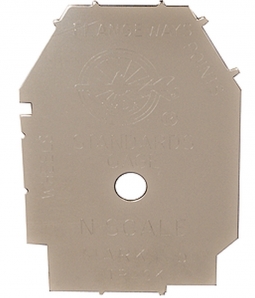Troubleshooting Model Railroad Derailment Issues
Model railroading is a beloved hobby for enthusiasts of all ages, combining the joy of crafting and engineering with the thrill of running miniature trains. However, one common frustration that can derail the fun—literally—is the issue of frequent derailments. In this guide, we’ll explore the common causes of derailments and provide practical solutions to keep your trains running smoothly.
Understanding the Basics
Before diving into troubleshooting, it’s essential to understand the basic components of a model railroad that could contribute to derailments:
- Tracks: The rails on which the train runs. Focus on your track-work if derailments occur at the same spot especially with multiple cars.
- Turnouts (Switches): Tracks that allow trains to move from one track to another. Like regular track, a particular turnout causing issues should draw your scrutiny.
- Rolling Stock: The cars and locomotives. If a particular car or loco has issues at numerous locations throughout your layout, it may well be the culprit and should be where you begin your investigation.
Common Causes of Derailments
Track Issues
- Misaligned Tracks: Even minor misalignments can cause derailments. The smaller the scale, the less room for error you have. Ensure tracks are perfectly aligned and connected. There should be no kinks at joints or in flex track.
- Dirty Tracks: Dust and debris can interfere with smooth operation. Regularly clean your tracks with a track cleaning car or a soft cloth. Dirty tracks will also lead to dirty wheels and electrical pickup issues.
- Improper Gradient: Steep or uneven grades can lead to derailments. Gradients should be gradual and smooth. Sudden changes in grade can cause wheels to lift from the rails temporarily.
- Rail Joiners: Loosely fitting rail-joiners can allow the offset connections between track sections. Replacing any work joiners will also improve electrical conductivity.
- Track Gauge: Out of gauge (rails to close or far apart) track can cause issues and be difficult to spot. You should look for this type of issue especially if derailments occur mid-track-section where a joint is not in play. An NMRA Standards Gauge can help verify gauge is with spec.
Turnout Problems


- Misaligned Points: Turnout points that do not fully switch can cause derailments. Adjust the points to ensure they fully engage and provide a smooth transition. Point tips can be gently filed if necessary.
- Debris in Turnouts: Small debris (including ballast) can obstruct the turnout mechanism. Regularly clean turnouts to ensure they operate smoothly. Another potential trouble spot is the frog (where the rails cross one another), where debris can lodge. In addition to debris, the manufacturing process can leave excessive plastic in the frog. It is a good practice to closely inspect new turnouts and resolve any issues before installation on the layout
- Track Gauge: Similar to general track issues, gauge and clearances are critical. These can also be checked with NMRA Standards Gauge.
Rolling Stock Issues
- Wheel Gauge: Wheels should be correctly gauged to the track. Use an NMRA standards gauge to check and adjust wheel spacing. Some wheels can be adjusted. If not, you can simply replace them. If axles are bent or wheels are out of true, replacement is the only option.
- Weight Distribution: Cars that are too light or unevenly weighted can derail. Adding balanced weight to cars can improve stability.
- Couplers: Truck mounted couplers can cause problems when backing trains as they tend to push the trucks outwards. The best practice is to replace them with body mounted couplers if this is causing issues.
- Radius: Longer cars often require larger radius curves. Larger cars often require 22" or 24" radius curves. The trucks on longer cars may not be designed to rotate enough to accommodate shorter radius curves. Additionally, the cars may push/pull adjacent cars off the tracks due to the excessive overhang. The same goes for smaller turnouts (especially those with 18" radius curved diverging routes).
Operational Errors
- Excessive Speed: Running trains too fast, especially through curves and turnouts, can lead to derailments. Maintain realistic speeds.
- Improper Handling: Hastily placing cars on the track can result in misaligned wheels. Carefully place cars on the track and ensure wheels are seated properly.
Troubleshooting Steps
Follow these steps to identify and fix derailment issues:

- Purchase an NMRA Standards Gauge! - Use this gauge to check track, turnouts, and rolling stock in following steps.
- Inspect the Track-work:
- Run a finger along the track to feel for bumps or misalignments.
- Use a level and/or straight-edge to check for uneven grades.
- Ensure all track joints are secure and smooth.
- Use a standards gauge to verify that is within tolerance.
- Examine Turnouts:
- Manually operate turnouts to ensure they switch completely.
- Remove any visible debris or obstructions.
- Check Rolling Stock:
- Use a standards gauge to check wheel spacing.
- Add weight to cars if they seem too light (NMRA provides guidelines on proper weight).
- Ensure couplers are at the correct height and aligned.
- Test Run and Observe:
- Slowly run a train over the section of track where derailments occur.
- Observe the train’s movement and note any irregularities.
- Make adjustments as needed based on observations.
Preventative Maintenance
- Regular Cleaning: Keep tracks, wheels, and turnouts clean.
- Routine Inspections: Periodically check track alignment, turnout operation, and wheel gauges.
- Proper Storage: Store rolling stock and track components in a manner that prevents warping or damage.
Conclusion
Derailments can be a significant source of frustration, but with systematic troubleshooting and regular maintenance, you can minimize these occurrences and enjoy a smooth-running model railroad. Remember, patience and attention to detail are key. By following these guidelines, you’ll keep your trains on track and your hobby enjoyable.
If you have any questions, please email us!
Happy railroading!
